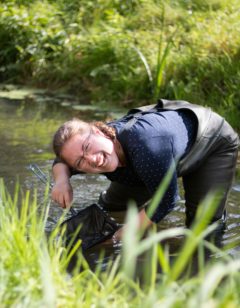
Currently on maternity leave
born, November 1980
Professional activity
since July 2013
Head of section Oribatida
Senckenberg Museum of Natural History Görlitz
Aug. 2012 – June 2013
Research assistant
Senckenberg Museum of Natural History Görlitz
in the project “Creation of the Red Lists 2020 – Preparatory Phase (FKZ 3511 861100)” of the Free University of Berlin for a test run Red Lists using the example of earthworms (Lumbricidae)
Jan. 2012 – June 2013
Research assistant
Senckenberg Museum of Natural History Görlitz
Scholarship of the Swiss foundation “Pro Acarologia Basiliensis” for the study of the “Oribatidensynusien in the nature reserve Dubringer Moor”
Jan. 2008 – Okt. 2012
Doctorand
Senckenberg Museum of Natural History Görlitz
July – Dez. 2007
Research assistant
University Oldenburg
in the joint project “Entomological investigation to combat bluetongue disease”
June 2006 – March 2007
Student assistant
Leibniz Institute of Freshwater Ecology and Inland Fisheries (IGB)
Alfred Wegener Institut (AWI) Potsdam
University Potsdam
Education
Okt. 2012
Senckenberg Museum of Natural History Görlitz
Degree: Doctorate (biology)
at the University of Leipzig; topic: The distribution routes of horn mites (Oribatida) and their immigration in raw soils
June – July 2010
Ohio State University
Soil Acarology Workshop, Acarology Summer Program
June 2006 – March 2007
Leibniz Institute of Freshwater Ecology and Inland Fisheries (IGB)
Degree: Diploma (Biology)
Topic: “Characterization of lake types of the North German Plain using aquatic coleoptera”.
Aug. – Okt. 2010
Elbe Brandenburg Biosphere Reserve
Work experience
Registration of the water beetles in the Rambower Moor
Sept. 2003 – Jan. 2004
University of Newcastle upon Tyne (Great Britain)
Semester abroad
Okt. 2001 – March 2007
University Potsdam
Degree: Diploma (biology)
Specialisation in ecology/nature conservation
2022
Escher, J., Hohberg, K., Decker, P., & Lehmitz, R. (2022). Ecology, genetics and distribution of Punctoribates zachvatkini, an oribatid mite so far overlooked in Germany. Experimental and Applied Acarology, 87(4), 289-307.
Schmidt, A., Schneider, C., Decker, P., Hohberg, K., Römbke, J., Lehmitz, R., & Bálint, M. (2022). Shotgun metagenomics of soil invertebrate communities reflects taxonomy, biomass, and reference genome properties. Ecology and Evolution, 12(6), e8991.
2020
Lehmitz, R., Haase, H., Otte, V. & Russell, D. (2020): Bioindication in peatlands by means of muti-taxa indicators (Oribatida, Aaraneae, Carabidae, Vegetation). Ecological Indicators 109, doi 10.1016/j.ecolind.2019.105837
2019
Graefe, U., Römbke, J. & Lehmitz, R. (2019): Die Waldbindung der Regenwürmer (Lumbricidae) Deutschlands. S.17-25. In: Dorow, W.H.O:, Blick S.U.P. & Schneider, A. (eds): Waldbindung ausgewählter Tiergruppen Deutschlands. Lumbricidae, Araneae, Opiliones, Pseudoscorpiones, Heteroptera, Coleoptera, Aculeata, Macrolepidoptera, Aves. BfN-Skripten 544. Bundesamt für Naturschutz, Bonn-Bad Godesberg. 388 S.
Schuppenhauer, M.M., Lehmitz, R. & Xylander, W.E.R. (2019) Slow-moving soil organisms on a water highway: aquatic dispersal and survival potential of Oribatida and Collembola in running water. Movement Ecology. 7(1):20
Maraun, M., Caruso, T., Hense, J., Lehmitz, R., Mumladze, L., Murvanidze, M., Nae, I, Schulz, J., Seniczak, A. & Scheu, S. (2019). Parthenogenetic vs. sexual reproduction in oribatid mite communities. Ecology and Evolution:1-9
2018
Balkenhol, B., Haase, H., Gebauer, P. & Lehmitz, R. (2018): Steeplebushes conquer the countryside – Influence of invasive plant species on spider communities (Araneae) in former wet meadows. Biodiversity and Conservation 27 (9): 2257-2274
2017
Schuppenhauer, M. M. & Lehmitz, R. (2017): Floating Islands: A method to detect aquatic dispersal and colonisation potential of soil microarthropods. – Soil Organisms 89 (2): 119–126
Lehmitz, R. & Decker, P. (2017): The nuclear 28S gene fragment D3 as species marker in oribatid mites (Acari, Oribatida) from German peatlands. Experimental and Applied Acarology 71(3), 259–276, doi 10.1007/s10493-017-0126-x
2016
Krause, A., Pachl, P., Schulz, G., Lehmitz, R., Senizcak, A., Schaefer, I., Scheu, S. & Maraun, M. (2016): Convergent evolution of aquatic life by sexual and parthenogenetic oribatid mites. Experimental and Applied Acarology, doi 10.1007/s10493-016-0089-3
Lehmitz, R., Römbke, J., Graefe, U., Beylich, A. & Krück, S. (2013): Rote Liste und Gesamtartenliste der Regenwürmer (Lumbricidae et Criodrilidae) Deutschlands. Naturschutz und Biologische Vielfalt, 70 (4) Wirbellose Tiere (Teil 2), 565-590.
Lehmitz, R. & Maraun, M. (2016): Small-scale spatial heterogeneity of stable isotope signatures (δ15N, δ13C) in Sphagnum sp. transfers to all trophic leverl in oribatid mites. Soil Biology & Biochemistry 100: 242-251.
2015
Xylander, W.E.R., Lehmitz, R., Hohberg, K., Lang, B., Russell, D.J. (2015) Boden ein unterschätzter Lebensraum. Biologie in unserer Zeit 6/2015: 388-395.
Lehmitz, R., Hohberg, K., Voigtländer, K. (2015) Senckenberg erforscht, wie Boden entsteht – Görlitzer Langzeitstudien zur Entwicklung von Bodenlebensgemeinschaften. Senckenberg – Natur Forschung Museum 145: 84-89.
Xylander, W.E.R., Lehmitz, R. & Lang, B. (2015): Unsere Böden – Unbeachtet, unverzichtbar und voller Leben. Senckenberg – Natur Forschung Museum 145: 74-77.
Hohberg, K., Lehmitz, R., Voigtländer, K. (2015) Wie ein Lebensraum entsteht – Bodentiere in der Bergbaufolge. The genesis of a habitat – Soil animals at post-mining sites. Senckenberg Jahresbericht 2013-2014 ISBN 978-3-929907-92-6: 36-42.
2014
Lehmitz, R. (2014): The oribatid mite community of a German peatland in 1987 and 2012 – effects of anthropogenic desiccation and afforestation. Soil Organisms 86 (2), 131-145.
Lehmitz, R., Römbke, J., Jänsch, S., Krück, S., Beylich, A. & U. Graefe (2014): Checklist of earthworms (Oligochaeta: Lumbricidae) from Germany. Zootaxa 3866, 2: 221-245
2012
Lehmitz, R. (2012): Die Verbreitungswege von Hornmilben (Oribatida) und ihre Einwanderung in Rohböden. – Dissertation, Universität Leipzig, Fakultät der Biowissenschaften, pp. 99.
Lehmitz, R (2012): Milben – vom Winde verweht. – Natur • Forschung • Museum 142, 3/4: 130-131
Lehmitz, R, Russell, D., Hohberg, K., Christian, A. & W.E.R. Xylander (2012): Active dispersal of oribatid mites into young soils. – Applied Soil Ecology 55: 10-19
2011
Hohberg, K., Elmer, M., Russell, D., Christian, A., Schulz, H.-J., Lehmitz, R., R. & M. Wanner (2011): First five years of soil food-web development in ‘Chicken Creek’ catchment. In: Elmer, M., Schaaf, W., Biemelt, D., Gerwin, W. & R.F. Hüttl (Eds.), The artificial catchment ‘Chicken Creek’ – initial ecosystem development 2005-2010. – Ecosystem Development 3: 93-114
Lehmitz, R., Russell, D. J., Hohberg, K., Christian, A., Xylander, W.E.R. (2011): Wind dispersal of oribatid mites as a mode of migration. – Pedobiologia 54: 201–207
2010
Lehmitz, R. (2010): Typisierung von Seen Norddeutschlands anhand aquatischer Coleoptera.- VDM-Verlag, ISBN 3639290593, pp. 116.
2009
Lehmitz, R. (2009): Aerial migration of oribatid mites.- 10th Central European Workshop on Soil Zoology, Ceské Budejovice, Abstract book, p. 48.
2008
Lehmitz, R., Christian, A. & W.E.R. Xylander (2008): Detection of migration mechanisms of oribatid mites.- EURECO-GFOE 2008, Proceedings, Verhandlungen der Gesellschaft für Ökologie 38: 449.

Head of section - Maternity leave replacement
born 04/12/1983
Professional activity
since 2018
PostDoc (research assistant)
Senckenberg Museum for Natural History Görlitz
Department of Soil Zoology, Section Mesofauna
Within MediAN Projekt
2015 – 2018
PostDoc (research assistant)
Georg-August-University Göttingen, Institute for Anthropology and Zoology, Department of Animal Ecology
2009 – 2015
PhD student
Georg-August-University Göttingen, Institute for Anthropology and Zoology, Department of Animal Ecology
2008 – 2008
Research trainee
Technical University Darmstadt, Institute of Zoology
2007 – 2009
Student assistant
Technical University Darmstadt, Institute of Zoology
Education
2010 – 2015
Georg-August-University Göttingen
Doctoral candidate in the study programme Biodiversity and Ecology
Degree: Dissertation (Dr. rer. nat.)
Title of dissertation: “Carbon flow in belowground food webs assessed by isotope tracers”.
2003 – 2009
Darmstadt University of Technology
Study of Biology
Main subjects: ecology, zoology, animal physiology
Degree: Diploma (Dipl. biol.)
Title of diploma thesis: “Variations in leaf litter food webs between biomes”.
2019
Li, Z., Scheunemann, N., Potapov, A. M., Shi, L., Pausch, J., Scheu, S., Pollierer, M. (accepted). The role of root-derived carbon for Collembola nutrition depends on plant type, functional group and species identity.
2018
Pausch, J., Hünninghaus, M., Kramer, S., Scharroba, A., Scheunemann, N., Butenschoen, O., Marhan, S., Bonkowski, M., Kandeler, E., Scheu, S., Kuzyakov, Y., Ruess, L., (2018). Carbon budgets of top- and subsoil food webs in an arable system. Pedobiologia – Journal of Soil Ecology 69, 29-33
2016
Müller, K., Kramer, S., Haslwimmer, H., Marhan, S., Scheunemann, N., Butenschoen, O., Scheu, S., Kandeler, E. (2016). Carbon transfer from maize roots and litter into bacteria and fungi depends on soil depth and time. – Soil Biology & Biochemistry, 93: 79–89.
Pausch, J., Kramer, S., Scharroba, A., Scheunemann, N., Butenschoen, O., Kandeler, E., Marhan, S., Riederer, M., Scheu, S., Kuzyakov, Y., Ruess, L. (2016). Small but active – pool size does not matter for carbon incorporation in belowground food webs. – Functional Ecology, 30: 479–489.
Scheunemann, N., Pausch, J., Digel, C., Kramer, S., Scharroba, A., Kuzyakov, Y., Kandeler, E., Ruess, L., Butenschoen, O., Scheu, S. (2016). Incorporation of root C and fertilizer N into the food web of an arable field: Variations with functional group and energy channel. – Food Webs, 9: 39–45.
2015
Scheunemann, N., Digel, C., Scheu, S., & Butenschoen, O. (2015). Roots rather than shoot residues drive soil arthropod communities of arable fields. – Oecologia, 179(4): 1135–1145.
Scheunemann, N., Maraun, M., Scheu, S., & Butenschoen, O. (2015). The role of shoot residues vs. crop species for soil arthropod diversity and abundance of arable systems. – Soil Biology & Biochemistry, 81: 81–88.
2012
Kramer, S., Marhan, S., Ruess, L., Armbruster, W., Butenschoen, O., Haslwimmer, H., Kuzyakov, Y., Pausch, J., Scheunemann, N., Schoene, J., Schmalwasser, A., Totsche, K. U., Walker, F., Scheu, S., Kandeler, E. (2012). Carbon flow into microbial and fungal biomass as a basis for the belowground food web of agroecosystems. – Pedobiologia, 55(2): 111–119.
2010
Scheunemann, N., Scheu, S., & Butenschoen, O. (2010). Incorporation of decade old soil carbon into the soil animal food web of an arable system. – Applied Soil Ecology 46(1): 59–63.




born December, 1990
Professional activity
since April 2016
PhD student
Senckenberg Museum of Natural History Görlitz
Department of Soil Zoology-Section Oribatida
Dez 2011 – Jun 2012
Student assistant
Botanica Science Center Bremen
Education
April 2020
TU Dresden
Degree: doctorate
Thesis: Investigations on passive aquatic dispersal and colonisation of oribatid mites using experimental and genetic methods
Feb 2014 – Feb 2016
University of Applied Sciences Bremen- City University of Applied Sciences
Degree: Master
International course of studies Technical and Applied Biology
Thesis: Contribution to the taxonomy of the genera Polynema and Stephanodes of Sweden,
Scholarships of the Entomological Associations (Entomologiska Förening) in Stockholm and Uppland
Aug 2014 – Feb 2015
Natural History Museum Stockholm
Internship in cooperation with Station Linné and the Naturhistoriska Riksmuseet
Field of research: Taxonomy of the Mymaridae (dwarf wasps), barcoding, next generation sequencing
Jan 2013 – Jul 2013
Station Linné, Öland
Internship in the field of entomology and taxonomy (Brachycera-Milichiidae)
Sep 2012 – Jan 2013
Linnéuniversitetet – Linnaeus University, Kalmar
Semester abroad with focus on limnology, marine and fish ecology
Okt 2010 – Jan 2014
University of Applied Sciences Bremen- City University of Applied Sciences
Degree: Bachelor
International course of studies Technical and Applied Biology
Final thesis: Macrozoobenthos in ditches of the city forest as a potential for settlement in a retention water
2020
Ronquist, R., Forshage, M., Häggqvist, S., Karlsson, D., Hovmöller, R., Bergsten, J., Holston, K., Britton, K., Abenius, J., Andersson, B., Buhl, P. N., Coulianos, C.-C., Fjellberg, A., Gertsson, C.-A., Hellqvist, S., Jaschhof, M., Kjærandsen, J., Klopfstein, S., Kobro, S., Liston, A., Meier, R., Pollet, M., Prous, M., Riedel, M., Roháček, J., Schuppenhauer, M., Stigenberg, J., Struwe, I., Taeger, A., Ulefors, S.-O., Varga, O., Withers, P. & Gärdenfors, U. (2020): Completing Linnaeus`s inventory of Swedish insect fauna: only 5000 species left? PLOS ONE 15 (3):
e0228561. https://doi.org/10.1371/journal.pone.0228561
2019
Schuppenhauer, M.M., Lehmitz, R. & Xylander, W.E.R. (2019) Slow-moving soil organisms on a water highway: aquatic dispersal and survival potential of Oribatida and Collembola in running water. Movement Ecology. 7(1):20
2018
Schuppenhauer, M. M. & Triapitsyn, S. V. (2018): Contribution to the taxonomy of Polynema Haliday, 1833 and Stephanodes Enock, 1909 (Hymenoptera: Mymaridae) of Sweden. – Entomologisk Tidskrift 139: 159–183
2017
Schuppenhauer, M. M. & Lehmitz, R. (2017): Floating Islands: A method to detect aquatic dispersal and colonisation potential of soil microarthropods. – Soil Organisms 89 (2): 119–126